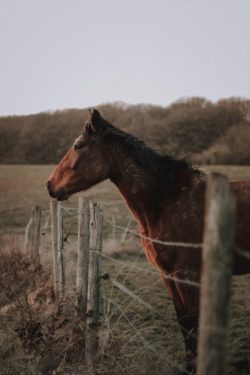Beautiful horses fencing for racing with their tails lifted or contentedly munching in luscious green fields flanked by a beautifully decorated fence are common countryside images. Even though these fences are aesthetically pleasing, they furthermore fulfill a functional purpose. Horse fences are required to keep horses safe while also allowing them to move and feed. Horses are more likely than other wildlife to harm themselves within fences due to their inherent escape impulse. Furthermore, some horses are quite precious, which warrants the additional expense of constructing a secure, robust, and appealing fence.
Horse care entails a lot of work. These big guns consume a lot of food, drink a lot of water, and require a lot of areas to move. You’ll need barns for them to sleep in and meadows for them to feed. Obviously, you’ll need to figure out a means to maintain them confined within the field so they don’t flee. This necessitates the use of the high-quality fence. After all, a horse can easily trip over flimsy fencing, so you’ll want to go with something substantial. However, many forms of fence would be a no for your horses since they are dangerous and potentially injurious. To make things easier, we’ve recommended the top five horse fencing horse fencing, also we will look over the discussion of which form of horse fencing you need to avoid.
Zareba 1 inch Wide 200m Polytape:
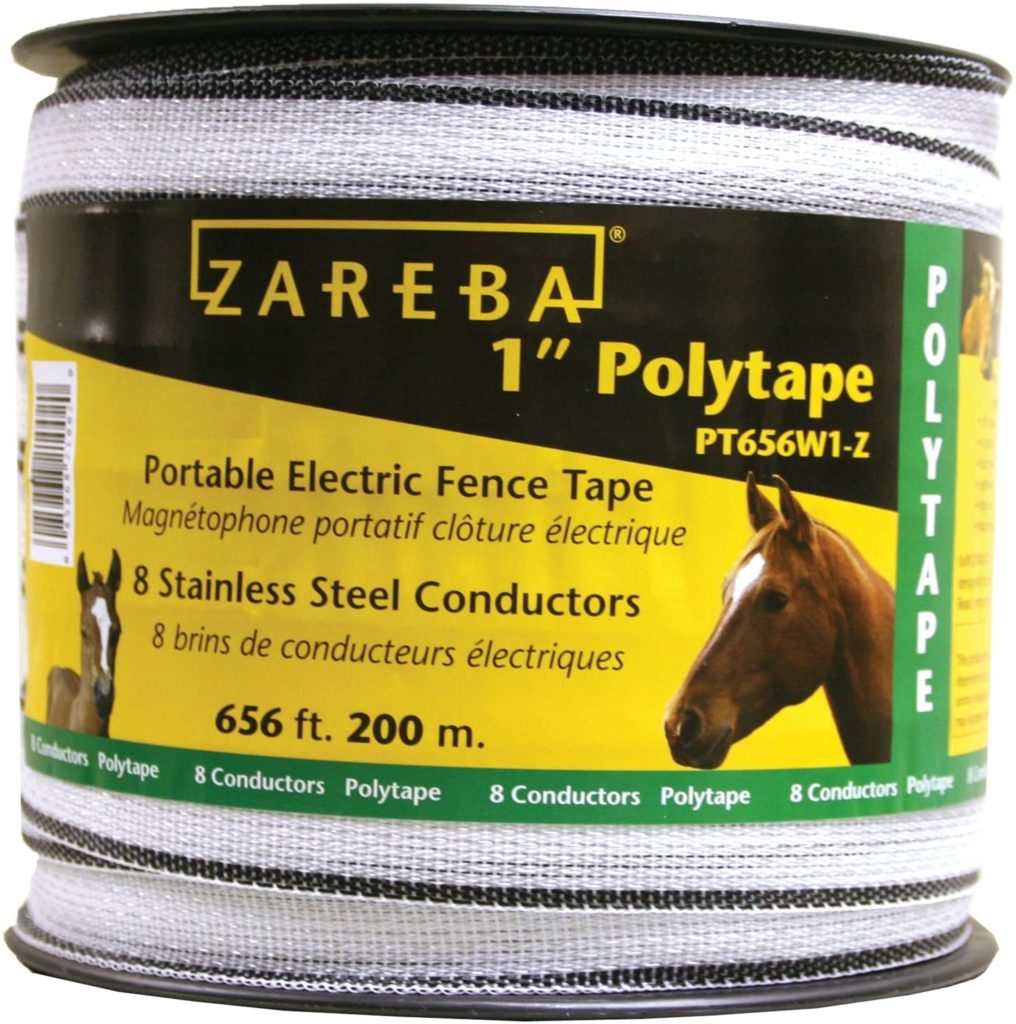

As it is much more prominent than standard wire, our Zareba one Inch Polytape is great for the equestrian fence. There are 8 layers of electrical cables with a 320-pound shattering strength. A regular wire is more difficult to set up, fix, and connect.
White polytape with a diameter of 1 inch and a length of 200 meters on a roll. You’ll probably need some insulators and a polytape to wire the charger interface.
Features:
- Horses and other animals may easily see polytape.
- Reel of polytape with a length of 656 feet that is 200 meters.
- Electrical conductors are woven into the fabric in eight segments.
- 320-pound sustaining weight.
- It’s easier to construct, fix, and reconnect thanks to the compact weave.
- Zareba polytape is non-corrosive.
Pros:
- Easy to handle
- Premium quality
- Prominent
- Easily reconnect
Cons:
- It requires professional installation.
ElectroBraid 1000 feet Reel:
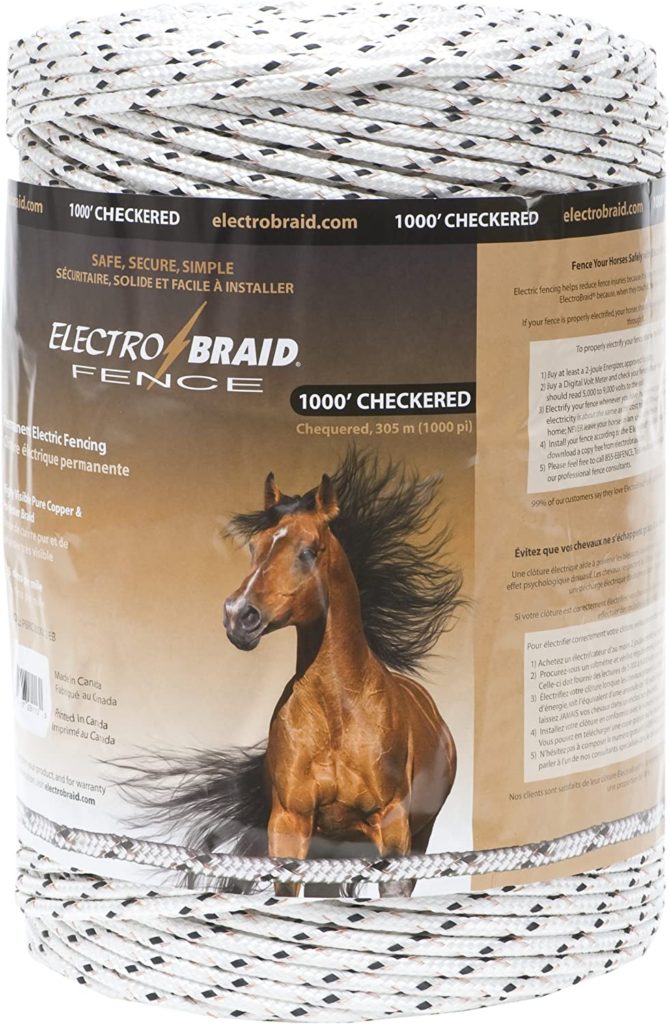

ElectroBraid is a one-fourth-inch wide, finely woven rope of high caliber. Our Braid comes in three colors that are black, checkered and white. A dual spiral of fiber optic carriers runs across the rope, giving for great transmission. ElectroBraid is purposely designed for horses and is considered more secure than almost than any style of horse fencing on the marketplace currently. To make a functional, appealing, and easy-to-maintain fence, it is preferred to use 3-4 wires of Electrobraid.
Specifications:
- A patterned fence line of 1,000 feet.
- Braided polyester fibers with a polypropylene base.
- Copper cable with a dual spiral
- UV-resistant materials are used.
- Surpasses the stringent criteria set for harnesses and parachute rigs.
- ElectroBraid is the most popular horse fence in the United States.
- Running it is secure, reliable, and quick.
Pros:
- Your life will be made easier by fencing that will last and make a noticeable difference for horses.
- Horses can easily detect and avoid a 1/4-inch line.
- Impact-absorbing fencing that pulls horses back.
- Copper strands conduct electricity four times as well as steel.
- There’s no need to tighten the fence line.
- ElectroBraid is made to reduce the risk of colliding with something. This Braid is the one that most equine veterinarians recommend.
- There are no severe impact injuries.
- There are no sharp points, edges, or wires that could pierce the skin.
- If a horse gets trapped in one of the ElectroBraid strands, it will break.
Cons:
- No sharp edges.
Zareba Heavy Duty Sure Shock Polyrope – 656 Feet:
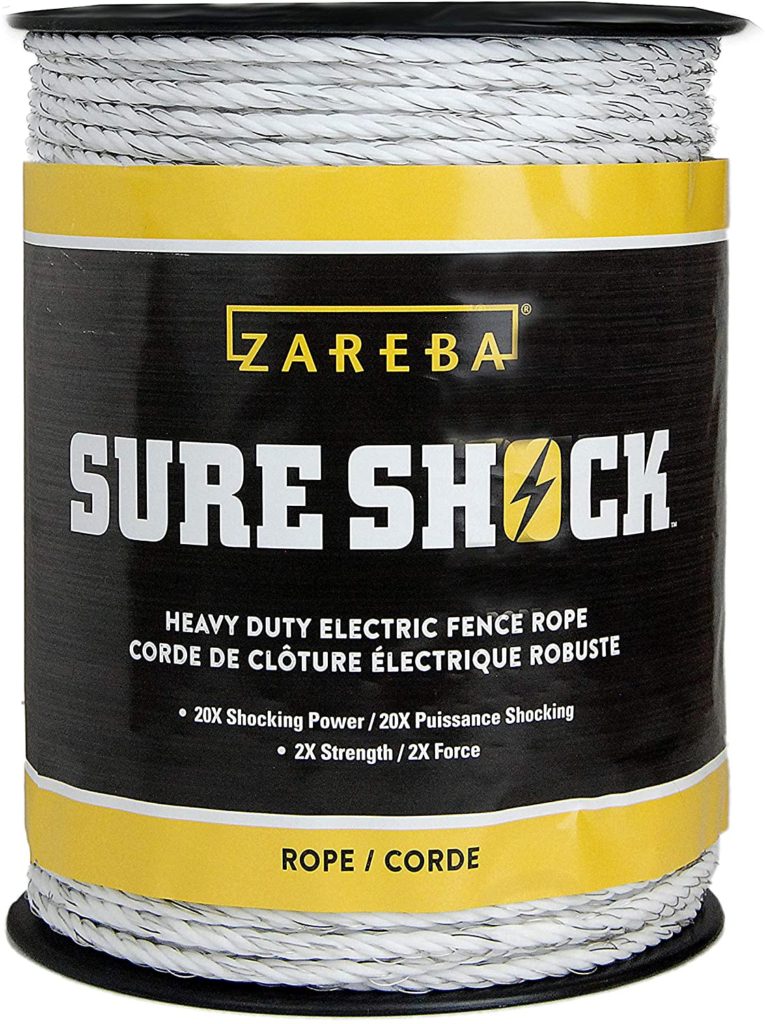

Zareba Heavy-Duty Sure Shock Polyrope is 656 Feet long and it is specially built to last.
For UV protection, this heavy-duty polyrope is constructed of PVC-coated fiberglass. This results in a fence line that is two times stronger than equivalent polyrope fences. Poly electric fencing is kinder to animals and aids in the creation of a visual barrier. Six highly conductive aluminum strands are woven into the polyrope. When compared to stainless steel conductors, these conductors provide a far stronger shock.
Specifications:
- Six metal wires that are very conductive and have a 20X startling power.
- 2X strength woven with PVC-coated high-density fiberglass.
- 656 feet of 8mm electric fence polyrope per reel, easy to install, repair, and splice while in the field.
- Lightweight and easy to transport for temporary pastures, rotational grazing, and horse confinement.
- UV protection that can withstand the elements for longer life in the field.
Pros:
- 20X Shocking strength
- Best suited for bulls, cattle & horses.
- Easy to install.
- Value for money.
Cons:
- Sharp edges.
Zareba Heavy-Duty Sure Shock Polywire – 1,320 Feet:
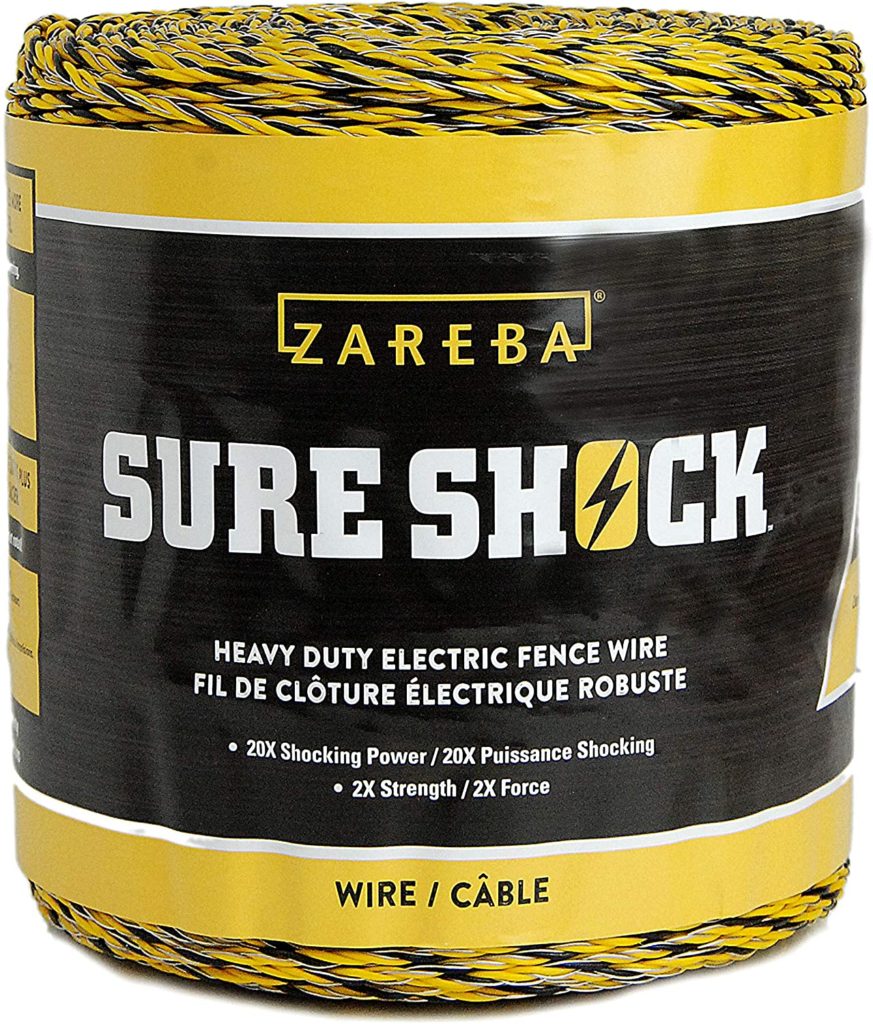

Zareba’s Sure Shock heavy-duty polywire is a lightweight, easy-to-install, repair, and splice polywire. Sure Shock comes on a spool with 1,320 feet of polywire interwoven with three highly conductive strands of aluminum wire. These aluminum wires provide a 20-fold stronger shock than stainless steel polywire, making them an extremely effective psychological barrier for your horses and cattle. When polywire is no longer needed, it can be coiled back onto its spool and used for another fence.
Specifications:
- Aluminum electric fence polywire on a 1,320-foot spool.
- It has 20 times the shocking power of stainless steel.
- Three extremely conductive aluminum wires are included.
- Lightweight and easy to transport for temporary pastures, rotational grazing, and horse confinement.
- UV-stabilized and PVC-coated fiberglass for long life.
- In the field, it’s simple to install, repair, and splice.
Pros:
- To keep your animals and horses contained within your internal paddocks, use Zareba’s Sure Shock electric fence polywire.
- Three highly conductive aluminum strands in this electric fencing line.
- It offers 20x the shocking power to animals that come into touch with it.
- The fiberglass weave on each 1,320-foot length of heavy-duty polywire has been PVC-coated to provide UV protection.
Cons:
- Delicate
Farmily Portable Electric Fence Polywire 656 Feet 200 Meter:
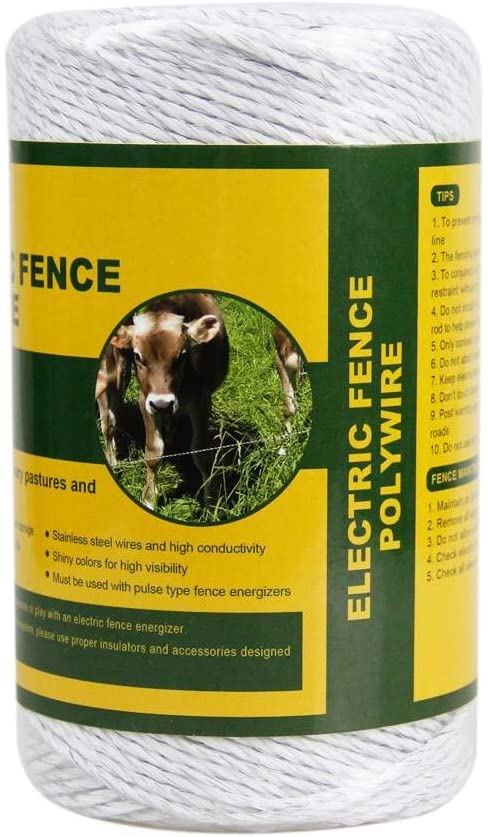

Polywire is an excellent fence material since it is more visible than typical metal wire, is lightweight, and is simple to install. Tightening, splicing, repairing, and rewinding polywire is a breeze.
Specifications:
- Polywire electric fence for livestock, perfect for temporary pastures and rotational grazing.
- High-visibility colors are ideal for temporary fencing.
- For relocation and storage, it can be easily reeled in and out.
- Long-lasting UV-stabilized polymer webbing
- There are six stainless steel wires with a high conductivity.
- This fence material is ideal for horse fencing, dog electric fencing, and goat electric fencing, and is the greatest option for portable fencing.
Pros:
- Ideal for use as temporary fencing.
- Six strands of electrical conductors made of stainless steel
- It’s simple to install, fix, splice, and rewind; it’s also reusable.
- It’s light and won’t rust.
- The length of the bridge is 200 meters (656 feet).
Cons:
- This product is not meant to withstand high tension and must be used in conjunction with a permanent fence.
Things to consider while buying the Perfect Fence:
Horse fences are not always the same height as fences used for other livestock. When scared or herded, horses are more athletic and more prone to jump a fence rather than go through or under it. Horse pasture fences should have a minimum height of 5 feet around them (60 inches). Most horses will not attempt to jump at this height, and humans will be less tempted to reach over the fence to pet or feed horses. Horses and people are both safe inside a 5-foot minimum height barrier.
The top of the fence should be at eye level with the horse’s eyes in paddocks (small pastures or turn-out areas less than 2 acres in size), corrals, and stallion enclosures. This is typically 4 to 6 inches above the withers of the horse. This height will discourage fighting over the fence and assist prevent horses from leaning over the fence, while an offset electric fence wire is the only definite way to eliminate leaning and rubbing on any fence.
Fences that separate pastures can be as high as 4.5 feet (54 inches). The fence should be 6 to 8 inches off the ground at the bottom. This is particularly essential with wire mesh fences because horses are less prone to paw at the fence and are more likely to graze the fence line. Furthermore, weed growth along the fence line is easier to control with herbicides or a weed-eater if this clearance is kept below the bottom of the fence. It also gives the fence an extra 6 inches of height for no additional cost.
Wood Fencing:
Wood fencing is tried and tested, and it has a long history of providing good horse fencing. It’s difficult to go wrong with some thick oak or comparable timber boards. This material is highly durable, so if you construct your fences properly, they will last a long time. Furthermore, wood is highly visible, and your horse will not run into it by accident. Granted, it’s not the most inexpensive material, and wood costs have been steadily rising in recent months. Wood also deteriorates over time due to inclement weather and your horses’ chewing, so you’ll have to replace boards frequently and perform a lot of basic ongoing maintenance.
PVC Fencing:
PVC fencing, like wood, will not rot in the weather and will not be chewed up by your horses. It’s virtually waterproof, and it may even mimic the look of a wood fence without the upkeep and effort. Of course, PVC comes in a variety of colors, including all-white and even some other hues, allowing for quite attractive aesthetics with no upkeep. However, this is one of the most expensive ways to build a fence. Moreover, these boards are engineered to break under pressure, and once your horses understand this, they’ll likely walk straight through them, which is why most PVC fences are used in conjunction with electric fencing.
Electric Fencing:
An electric fence operates on the same psychological principle. After receiving a shock from the fence, your horse will learn to avoid touching it in the future for fear of receiving another shock. These shocks, on the other hand, are not hazardous; they will not hurt your horse and will serve as a strong deterrent, even if they are unpleasant for your horse to experience. The issue with electric fencing is that it is all part of one system, so if something goes wrong with it, nothing else will operate. In addition, unlike wooden or PVC fences, which you can simply install yourself, electric fencing requires the assistance of a specialist. Electric fencing, in general, works well with other types of fencing.
Wire fencing:
Wire fencing is one of the most affordable horse-safe fencing options. It’s also quite simple to set up, making it even more accessible to the majority of people. It’s true that wire fencing is one of the weaker fencing options, and horses will frequently lean on it, gradually losing its shape. Furthermore, wire fencing has some of the poorest visibility of any fencing on our list, which might spell disaster if your horse goes into it at full speed. For these reasons, wire fencing is sometimes paired with PVC or wood fencing for increased visibility, as well as electric fencing to discourage horses from leaning against it.
Horse Fencing You Should Never Use:
Barbed Wire
While the barbed wire is good at keeping unwelcome visitors out, using it to keep your horses in is a bad idea. Barbed wire can easily injure a horse, even if it is merely leaning against it. If your horse collides with barbed wire at full speed, it might be fatal.
Square Mesh with large openings in a square shape:
While V-mesh fencing is ideal for horses, fencing with wide apertures is not. Your horse’s hooves could become trapped in the openings if they are larger than 3 inches, causing harm to both the horse and the fence. Make sure any mesh fencing you use has holes no bigger than 3 inches in diameter.
While most of these fencing styles are successful on their own, combining more than one form of fencing frequently yields the best results. PVC fencing, for example, is stylish and weather-resistant, but it is easily broken. When used in conjunction with electric fencing, horses will be unable to break it; nevertheless, you will only need a single strand of electric fencing, lowering expenditures. These fencing styles can be combined in a variety of ways, so consider what each fencing type has to offer and how different forms of fencing can complement one another.
FAQs:
What kind of horse fencing is best?
Wire fences are one of the safest fences for horses since they are sturdy and lasting. They are less expensive than most rail fences but more expensive than traditional farm-woven fences for cattle and other livestock with 4- to 6-inch openings.
What color fence does a horse prefer to see?
Black fencing is popular among farmers because of its visibility in snowy conditions and its tendency to hide dirt. Brown is a more subdued color that has a more natural appearance, and it goes nicely with tan and neutral barn/house colors. Brown fencing also makes dirt and muck harder to see.
How much space does a horse require?
Professionals recommend a minimum of two acres for the first horse and an additional acre for each subsequent horse (e.g., five acres for four horses). And, depending on the forage quality of your specific property, more land is always preferable.
Is an electric fence required for horses?
These fences are very easy to see. Horses’ depth perception is limited due to the anatomy of their heads. It’s tough for them to see a single strand of metal conductor line because of this. For the animal to identify the correction with the fence, it must first recognize the existence of an electric fence.
What type of horse fencing is the most cost-effective?
One of the cheapest horse fence materials is electric wire or rope fencing, which is also one of the easiest to build and remove. This type of fencing is the most cost-effective. The price of this sort of fence is determined by the type and quantity of strands utilized, as well as the energizer selected.
Conclusion:
Finally, we can’t really tell you which type of horse fencing is best because everyone’s situation is different. All of the five varieties of fencing we’ve examined in this article are excellent choices, and you won’t be dissatisfied with any of them, but several of them can be enhanced by combining them with other fencing types. To select which type of fencing is best for your space and horses, you’ll need to consider factors such as your budget, space, and preferences. We like V-mesh since it is one of the safest types of fences for horses, but we believe that each style of fencing we’ve listed has its time and place.
